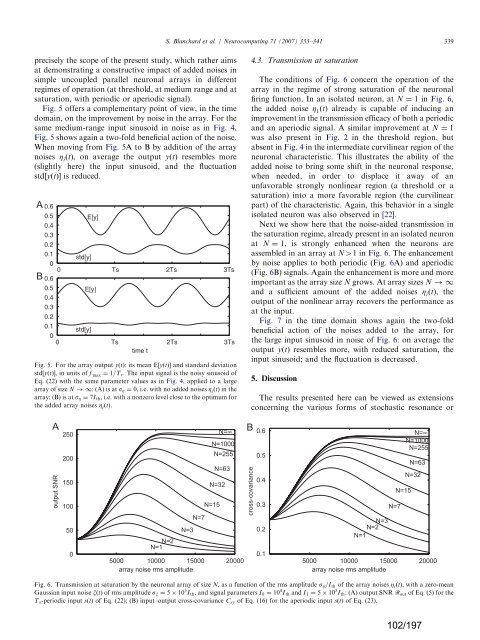a la physique de l'information - Lisa - Université d'Angers
a la physique de l'information - Lisa - Université d'Angers
a la physique de l'information - Lisa - Université d'Angers
Create successful ePaper yourself
Turn your PDF publications into a flip-book with our unique Google optimized e-Paper software.
precisely the scope of the present study, which rather aims<br />
at <strong>de</strong>monstrating a constructive impact of ad<strong>de</strong>d noises in<br />
simple uncoupled parallel neuronal arrays in different<br />
regimes of operation (at threshold, at medium range and at<br />
saturation, with periodic or aperiodic signal).<br />
Fig. 5 offers a complementary point of view, in the time<br />
domain, on the improvement by noise in the array. For the<br />
same medium-range input sinusoid in noise as in Fig. 4,<br />
Fig. 5 shows again a two-fold beneficial action of the noise.<br />
When moving from Fig. 5A to B by addition of the array<br />
noises Z iðtÞ, on average the output yðtÞ resembles more<br />
(slightly here) the input sinusoid, and the fluctuation<br />
std½yðtÞŠ is reduced.<br />
0.6<br />
0.5<br />
0.4<br />
0.3<br />
0.2<br />
E[y]<br />
0.1<br />
0<br />
std[y]<br />
0 Ts 2Ts 3Ts<br />
0.6<br />
0.5<br />
0.4<br />
0.3<br />
0.2<br />
E[y]<br />
0.1<br />
0<br />
0<br />
std[y]<br />
Ts 2Ts 3Ts<br />
time t<br />
Fig. 5. For the array output yðtÞ: its mean E½yðtÞŠ and standard <strong>de</strong>viation<br />
std½yðtÞŠ, in units of f max ¼ 1=T r. The input signal is the noisy sinusoid of<br />
Eq. (22) with the same parameter values as in Fig. 4, applied to a <strong>la</strong>rge<br />
array of size N !1: (A) is at sZ ¼ 0, i.e. with no ad<strong>de</strong>d noises Z iðtÞ in the<br />
array; (B) is at sZ ¼ 7I th, i.e. with a nonzero level close to the optimum for<br />
the ad<strong>de</strong>d array noises Z iðtÞ.<br />
output SNR<br />
250<br />
200<br />
150<br />
100<br />
50<br />
0<br />
N=1 N=2<br />
ARTICLE IN PRESS<br />
S. B<strong>la</strong>nchard et al. / Neurocomputing 71 (2007) 333–341 339<br />
N=3<br />
N=7<br />
N=255<br />
N=32<br />
N=15<br />
N=∞<br />
N=1000<br />
N=63<br />
5000 10000 15000 20000<br />
array noise rms amplitu<strong>de</strong><br />
cross-covariance<br />
4.3. Transmission at saturation<br />
The conditions of Fig. 6 concern the operation of the<br />
array in the regime of strong saturation of the neuronal<br />
firing function. In an iso<strong>la</strong>ted neuron, at N ¼ 1inFig. 6,<br />
the ad<strong>de</strong>d noise Z 1ðtÞ already is capable of inducing an<br />
improvement in the transmission efficacy of both a periodic<br />
and an aperiodic signal. A simi<strong>la</strong>r improvement at N ¼ 1<br />
was also present in Fig. 2 in the threshold region, but<br />
absent in Fig. 4 in the intermediate curvilinear region of the<br />
neuronal characteristic. This illustrates the ability of the<br />
ad<strong>de</strong>d noise to bring some shift in the neuronal response,<br />
when nee<strong>de</strong>d, in or<strong>de</strong>r to disp<strong>la</strong>ce it away of an<br />
unfavorable strongly nonlinear region (a threshold or a<br />
saturation) into a more favorable region (the curvilinear<br />
part) of the characteristic. Again, this behavior in a single<br />
iso<strong>la</strong>ted neuron was also observed in [22].<br />
Next we show here that the noise-ai<strong>de</strong>d transmission in<br />
the saturation regime, already present in an iso<strong>la</strong>ted neuron<br />
at N ¼ 1, is strongly enhanced when the neurons are<br />
assembled in an array at N41 inFig. 6. The enhancement<br />
by noise applies to both periodic (Fig. 6A) and aperiodic<br />
(Fig. 6B) signals. Again the enhancement is more and more<br />
important as the array size N grows. At array sizes N !1<br />
and a sufficient amount of the ad<strong>de</strong>d noises Z iðtÞ, the<br />
output of the nonlinear array recovers the performance as<br />
at the input.<br />
Fig. 7 in the time domain shows again the two-fold<br />
beneficial action of the noises ad<strong>de</strong>d to the array, for<br />
the <strong>la</strong>rge input sinusoid in noise of Fig. 6: on average the<br />
output yðtÞ resembles more, with reduced saturation, the<br />
input sinusoid; and the fluctuation is <strong>de</strong>creased.<br />
5. Discussion<br />
The results presented here can be viewed as extensions<br />
concerning the various forms of stochastic resonance or<br />
0.6<br />
0.5<br />
0.4<br />
0.3<br />
0.2<br />
0.1<br />
N=2<br />
N=1<br />
N=3<br />
N=7<br />
N=15<br />
N=∞<br />
N=1000<br />
N=255<br />
N=63<br />
N=32<br />
5000 10000 15000 20000<br />
array noise rms amplitu<strong>de</strong><br />
Fig. 6. Transmission at saturation by the neuronal array of size N, as a function of the rms amplitu<strong>de</strong> sZ=I th of the array noises Z iðtÞ, with a zero-mean<br />
Gaussian input noise xðtÞ of rms amplitu<strong>de</strong> sx ¼ 5 10 3 I th, and signal parameters I 0 ¼ 10 4 I th and I 1 ¼ 5 10 3 I th: (A) output SNR Rout of Eq. (5) for the<br />
T s-periodic input sðtÞ of Eq. (22); (B) input–output cross-covariance Csy of Eq. (16) for the aperiodic input sðtÞ of Eq. (23).<br />
102/197


